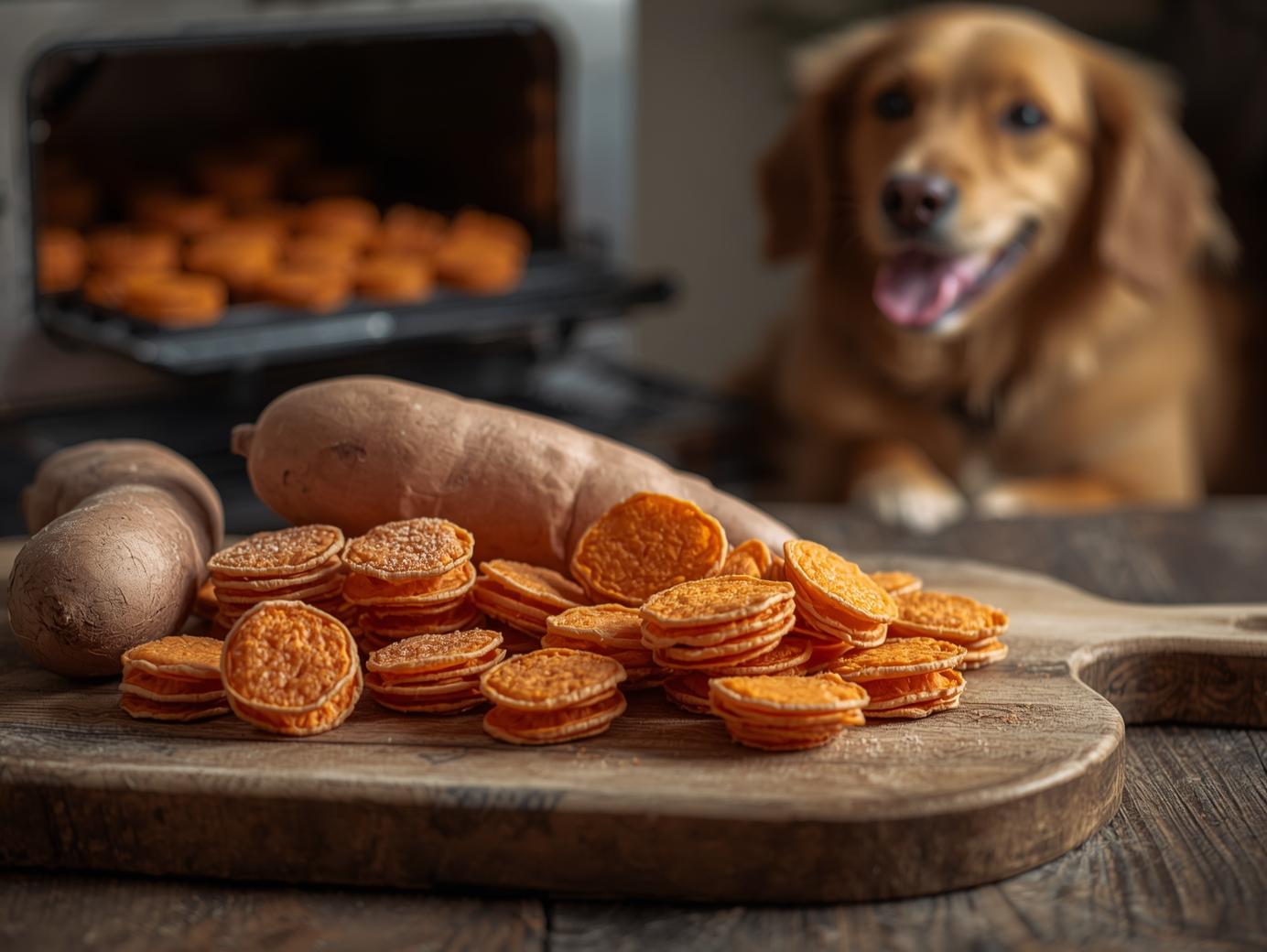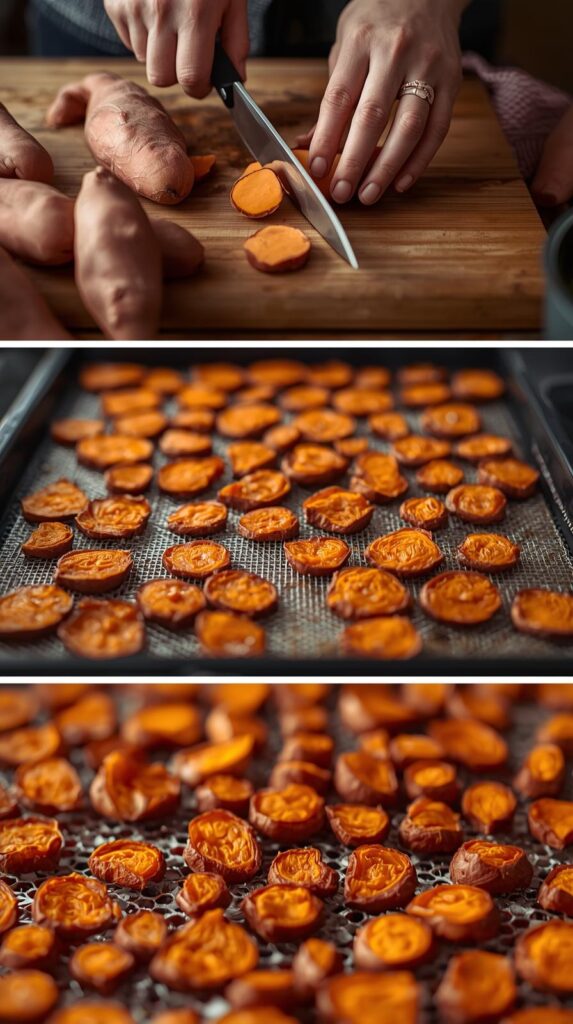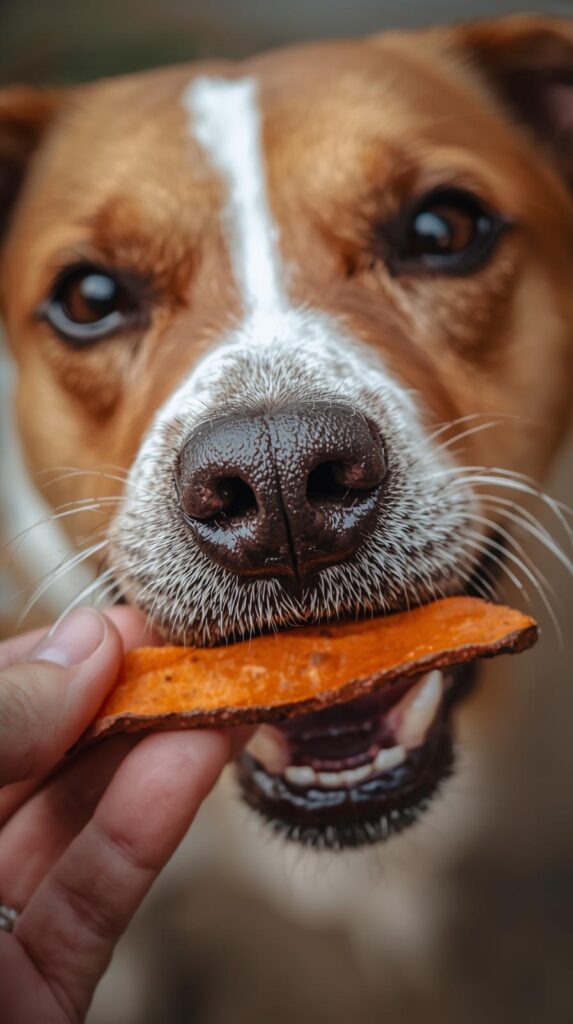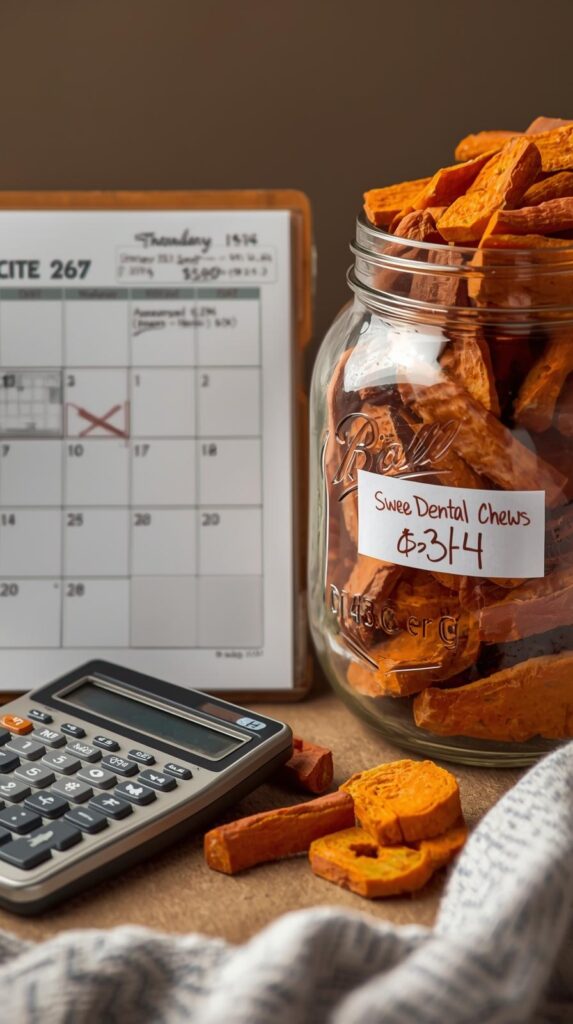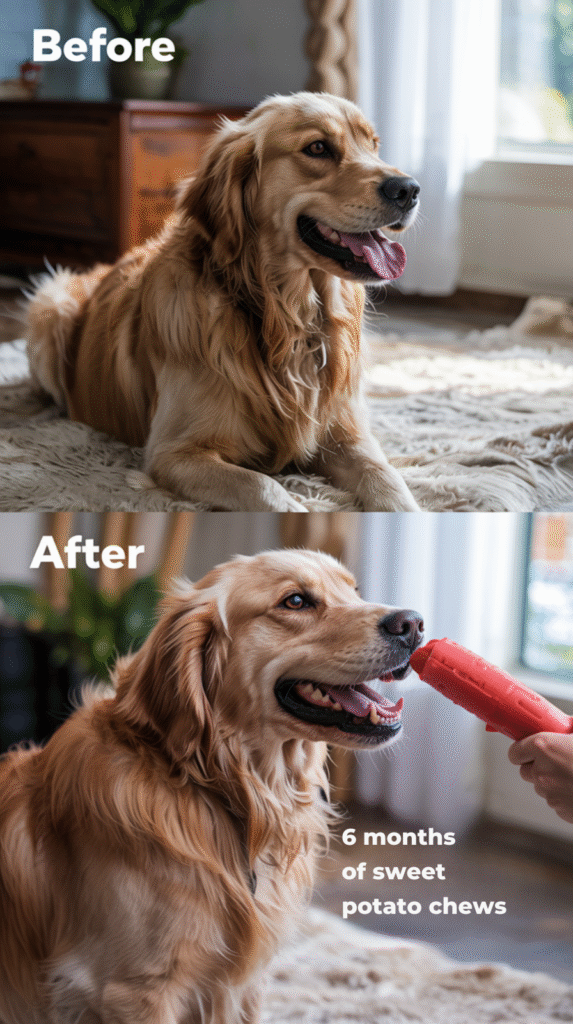Here’s something nobody tells you when you get a dog: dental chews are expensive. Like, “I could buy myself lunch for what this bag of chewy sticks costs” expensive. And half the time, the ingredient list reads like a chemistry experiment gone wrong.
I was dropping serious money on dental chews every month until I discovered the magical world of dehydrated sweet potato chews. And when I say “discovered,” I mean I accidentally made them when I was trying to meal prep sweet potatoes for myself and thought, “Huh, my dog would probably like these.”
Spoiler alert: He loved them. Like, “forgot about every store-bought chew instantly” loved them.
These homemade dog biscuits are literally just sweet potato. That’s it. One ingredient. And somehow, they’re better than anything I’ve bought at a pet store. They satisfy my dog’s chewing needs, help keep his teeth cleaner, and cost about 1/10th of what I was spending before. Plus, they last forever in storage, which means I can make a huge batch and forget about it for weeks.
Ready to save money and ditch those mystery-ingredient dental chews? Let’s talk about why dehydrated sweet potato chews are about to become your new obsession.
The Basic Dehydrated Sweet Potato Chews
Why It’s Awesome: This is the most stripped-down, back-to-basics recipe you’ll find. One ingredient. Minimal effort. Maximum results. If you’re even slightly suspicious of what’s in commercial dog treats, these sweet potato dog treats will give you total peace of mind.
Ingredients
- 2-4 large sweet potatoes (go for organic if you can—you’re not peeling these)
Equipment You’ll Need
- A dehydrator (I use a basic $40 one from Amazon)
- OR an oven (preferably one that goes down to 170°F or has a “warm” setting)
- A sharp knife or mandoline
- Patience (optional but recommended)
Step-by-Step Instructions
- Wash your sweet potatoes thoroughly—you’re keeping the skin on for extra nutrients and fiber.
- Slice them into rounds or lengthwise strips about ¼-inch thick. Consistency matters here; try to keep them all the same thickness so they dehydrate evenly.
- Pat the slices dry with paper towels (this speeds up the dehydration process).
- If using a dehydrator: Arrange slices in a single layer on dehydrator trays (no overlapping). Set temperature to 135°F. Dehydrate for 10-12 hours, checking at the 8-hour mark.
- If using an oven: Preheat to the lowest setting (170-200°F). Place slices on a baking rack set over a baking sheet (this allows air circulation). Bake for 3-4 hours, flipping halfway through.
- They’re done when they’re leathery and chewy but not brittle or crispy. You want some bend to them.
- Let cool completely before storing in an airtight container.
Why You’ll Love It
These are the definition of healthy dog snack recipes. Sweet potatoes are packed with vitamins A, B6, and C, plus fiber and antioxidants. The chewy texture naturally helps clean teeth as your dog works on them. And here’s the kicker: most dogs will spend 10-15 minutes working on a single chew, which means mental stimulation and dental benefits. I once timed my dog, and he spent 23 minutes on a particularly good piece. That’s 23 minutes of peace and quiet for me, which honestly might be the real benefit here.
Variations & Flavor Twists
Why It’s Awesome: While plain dehydrated sweet potato is perfect, sometimes you want to mix things up. These variations add minimal ingredients but maximum interest for your pup.
Cinnamon-Dusted Sweet Potato Chews
Before dehydrating, very lightly dust the slices with cinnamon (we’re talking a barely-visible sprinkle). The warmth of cinnamon complements the natural sweetness, and it smells amazing while dehydrating.
Coconut Oil Sweet Potato Strips
Lightly brush each slice with melted coconut oil before dehydrating. This adds healthy fats, makes them slightly shinier, and can help with coat health. Don’t overdo it though—a light brushing is plenty.
Savory Sweet Potato Chews
Mix 1 tablespoon of bone broth powder (check it’s dog-safe and low-sodium) with 2 tablespoons water to make a paste. Brush this onto slices before dehydrating for a savory version that’s great for dogs who aren’t big on sweet flavors.
Multi-Veggie Dehydrator Mix
Combine sweet potato slices with thinly sliced carrots and zucchini rounds. Dehydrate together for a variety pack. The different textures and flavors keep things interesting.
The Equipment Question (Do You Really Need a Dehydrator?)
The Real Talk: This is the question everyone asks, so let’s address it head-on.
If You Have a Dehydrator
You’re living the dream. Dehydrators are specifically designed for this, they maintain consistent low temperatures, and they can run overnight without you worrying. They’re more energy-efficient than ovens for long dehydration times, and the results are more consistent.
My take: If you plan to make these regularly (and trust me, once you start, you will), a basic dehydrator is worth it. I got mine for $40 on sale, and it’s paid for itself ten times over compared to what I was spending on dental chews.
If You’re Using an Oven
This absolutely works—it’s just less convenient. The main challenges are:
- Most ovens don’t go below 170°F, which means faster dehydration but less control
- You need to prop the oven door open slightly to let moisture escape (use a wooden spoon)
- It’s harder to dehydrate overnight because, well, oven safety
- They use more electricity for the same result
My take: Start with your oven to see if you like making these. If you find yourself doing it monthly, invest in a dehydrator. Your electric bill will thank you.
Alternative: The “I’m Broke But Creative” Method
On very low humidity days, you can actually sun-dry sweet potato slices if you’re committed. Place them on elevated racks in direct sunlight, cover with cheesecloth to keep bugs off, and bring them in at night. This takes 2-3 days but costs zero dollars. I’ve never actually done this because patience is not my strong suit, but I have a friend who swears by it.
Storage & Shelf Life (The Boring But Important Stuff)
Why It’s Awesome: One of the best things about these dehydrated sweet potato chews is how long they last. Unlike fresh treats that go bad in days, these can stick around for months if stored properly.
How to Store
- Airtight containers: Glass jars, sealed plastic containers, or even Ziploc bags work great
- Cool, dry place: Pantry, cupboard, or even a dedicated shelf
- Avoid moisture: This is the enemy of dehydrated anything
- Optional: Throw in a food-safe silica gel packet (the kind that comes in vitamin bottles) to absorb any residual moisture
How Long They Last
- Properly stored: 3-4 months easily
- In the freezer: Up to 6 months
- In reality: They never last that long because your dog will demand them constantly
Signs They’ve Gone Bad
- Mold (throw them out immediately—not worth the risk)
- Off smell (should smell like sweet potato, nothing else)
- Excessive brittleness (means they got too dry, still safe but less enjoyable to chew)
- Soft/squishy texture when they should be leathery (moisture got in, probably best to toss)
Pro tip: I write the date on my storage container with a dry-erase marker. It helps me track freshness, and it makes me look organized when people visit and see my labeled dog treat jars. Small wins.
The Dental Benefits (Why Your Vet Might Actually Approve)
Why It’s Awesome: I’m not a veterinarian, but after two years of making these, I’ve had three different vets compliment my dog’s teeth. That’s not coincidence.
How They Help
Mechanical cleaning: The chewy, slightly fibrous texture naturally scrapes against teeth as your dog works on the chew, helping remove plaque buildup.
Extended chewing time: Unlike treats your dog inhales in three seconds, these require actual work. The extended chewing promotes saliva production, which naturally helps clean teeth and neutralize bacteria.
Jaw exercise: Chewing strengthens jaw muscles and keeps them engaged in a healthy way.
Gum massage: The texture provides gentle gum stimulation, which promotes blood flow and gum health.
What They Don’t Replace
Real Talk: These chews are great supplemental dental care, but they’re not magic. They don’t replace:
- Regular teeth brushing (yeah, I know, but try anyway)
- Professional dental cleanings when needed
- Veterinary care for existing dental issues
Think of them as flossing—helpful and beneficial, but not a substitute for actual dental hygiene.
My Experience
Before I started making these, my dog needed professional dental cleaning every 18 months. Since introducing dehydrated sweet potato chews as a daily thing (he gets one every evening), we’ve stretched that to every 2.5+ years. My vet specifically said his teeth look better than expected for his age. Is it entirely because of the sweet potato chews? Probably not. But am I going to keep making them? Absolutely.
Troubleshooting Common Issues
They’re too hard/brittle You over-dehydrated them. They should be leathery and chewy, not crunchy. Try reducing your dehydration time by an hour or two next batch, or increase the thickness of your slices slightly.
They’re still too moist/soft Under-dehydrated. They need more time. If they feel at all squishy or bendy without resistance, put them back in. Moist = shorter shelf life and potential mold issues.
They’re browning too much in the oven Your oven temp is too high. Try going even lower, or use the “warm” setting if your oven has one. The browning itself isn’t harmful, but it can make them taste slightly bitter.
My dog isn’t interested Some dogs need to be introduced to new textures gradually. Try giving your dog a piece while it’s still slightly warm from the dehydrator—the smell is stronger and more appealing. Or break a piece into smaller bits and use them as training treats to build positive associations.
They’re not lasting as long as I expected (storage-wise) Moisture is getting in. Make sure your storage container seals properly, and check that the chews were fully dehydrated before storing. One slightly moist piece can affect the whole batch.
My slices are dehydrating unevenly Thickness consistency is key. Try using a mandoline slicer for more uniform pieces. Also, rotate the trays if using a dehydrator (top and bottom trays often dry at different rates).
Beyond Basic: Getting Creative
Why It’s Awesome: Once you’ve mastered the basic sweet potato dog treats, you can start experimenting with shapes, sizes, and uses.
Size Variations
Chips (thin slices): Dry faster, crunchier, great for training treats Standard (¼-inch): Perfect all-purpose chew, good for most dogs Thick chunks (½-inch+): Long-lasting heavy chewers’ version, takes longer to dehydrate but lasts longer to chew
Shape Matters
Rounds: Classic, even dehydration Lengthwise strips: Great for larger dogs, more surface area for teeth cleaning Cubes: If you’re feeling fancy, cut into small cubes for bite-sized treats Fries: Cut into long, thin strips for a fun variation
Multi-Purpose Uses
Training treats: Break dehydrated chips into small pieces for positive reinforcement Kong stuffing: Rehydrate small pieces in warm water and stuff into a Kong with peanut butter Travel snacks: They don’t require refrigeration, making them perfect for trips Calming distraction: Give one before stressful events (vet visits, grooming, thunderstorms)
Conclusion
Look, I’m not going to lie and say making dehydrated sweet potato chews is glamorous. You’re literally watching vegetables slowly dry for hours. But the payoff? Totally worth it.
These dog treats homemade have saved me hundreds of dollars, given me peace of mind about what my dog is eating, and genuinely improved his dental health. They’re one ingredient, they last forever, and they make me feel like a responsible dog parent without actually requiring much effort.
The best part is watching your dog’s face when you hand them a chew. There’s something deeply satisfying about knowing you made something your dog loves from scratch, especially when “from scratch” literally means “slice and wait.”
Whether you’re trying to save money, avoid weird ingredients in commercial treats, or just want to give your dog something healthy to chew on, these sweet potato dog treats are it. They’re not sexy, they’re not Instagram-perfect (unless you’re really good at food photography), but they’re honest, wholesome, and effective.
So grab some sweet potatoes, set aside a few hours, and join me in the world of dehydrated dog treat making. Your dog will thank you, your wallet will thank you, and your vet might even give you one of those rare “you’re doing something right” nods at the next checkup.
Now if you’ll excuse me, I have a batch dehydrating right now, and my dog has been sitting in front of the dehydrator for the past hour like it’s going to magically speed up the process through sheer force of will. The dedication is real, folks 😂
Printable Recipe Card
Want just the essential recipe details without scrolling through the article? Get our printable recipe card with just the ingredients and instructions.

